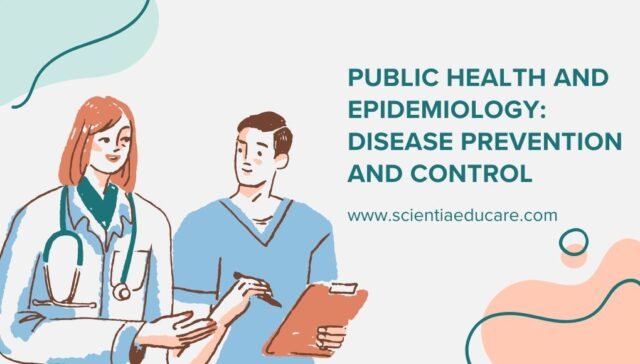Public Health and Epidemiology: Strategies for Effective Disease Prevention and Control
Introduction
Public health and epidemiology are crucial fields in safeguarding community well-being by preventing diseases and controlling their spread. With a systematic approach, these fields help in identifying risk factors, implementing preventive measures, and ensuring overall public safety. This module explores the strategies used in disease prevention and control, along with the role of epidemiology in tracking and mitigating health threats.
Best practices for disease prevention,
Public health strategies for communities,
Low-cost epidemiology research methods,
How to improve infection control,
Effective public health awareness campaigns.
Understanding Public Health
Public health focuses on protecting and improving health at the community level through organized efforts, policies, and awareness programs. It includes:
- Health promotion: Educating the public on healthy habits
- Disease prevention: Vaccinations, screenings, and hygiene practices
- Environmental health: Monitoring water, air, and food quality
- Health policy and management: Formulating laws for public health safety
Key Public Health Initiatives
- Immunization Programs: Prevents infectious diseases like measles, polio, and influenza.
- Sanitation Improvements: Clean drinking water and waste management reduce diseases like cholera.
- Health Education Campaigns: Awareness about hygiene, nutrition, and physical activity to reduce lifestyle diseases.
Epidemiology: The Science of Disease Tracking
Epidemiology is the study of disease distribution, patterns, and determinants in populations. It helps in understanding the causes and control measures for health-related issues.
Core Functions of Epidemiology
- Surveillance: Monitoring diseases to detect outbreaks early.
- Field Investigations: Identifying sources and risk factors of diseases.
- Analytical Studies: Researching associations between risk factors and diseases.
- Evaluation: Assessing the effectiveness of public health programs.
Types of Epidemiological Studies
- Descriptive Studies: Document patterns of disease occurrence.
- Analytical Studies: Investigate causes and risk factors.
- Experimental Studies: Test interventions for disease prevention.
Strategies for Disease Prevention and Control
1. Primary Prevention
- Vaccination Programs (e.g., WHO’s Expanded Program on Immunization)
- Lifestyle Modifications (e.g., promoting physical activity, healthy eating)
- Environmental Measures (e.g., reducing pollution, ensuring clean water supply)
2. Secondary Prevention
- Early Diagnosis and Screening (e.g., cancer screenings, blood pressure monitoring)
- Health Check-ups (e.g., detecting diabetes, cardiovascular risks early)
- Quarantine and Isolation (e.g., containing contagious diseases like COVID-19)
3. Tertiary Prevention
- Rehabilitation Programs (e.g., therapy for stroke patients)
- Chronic Disease Management (e.g., diabetes control programs)
- Support Groups (e.g., mental health and substance abuse support)
Role of Government and International Organizations
World Health Organization (WHO)
- Provides global health guidelines
- Coordinates international disease response efforts
- Implements immunization programs
Centers for Disease Control and Prevention (CDC)
- Conducts research and provides disease surveillance
- Develops strategies for disease prevention
National Health Agencies
- Implement local health policies
- Conduct public health campaigns
Emerging Challenges in Disease Control
- Antimicrobial Resistance (AMR): Overuse of antibiotics leading to drug-resistant bacteria.
- Climate Change and Health: Increased spread of vector-borne diseases.
- Global Pandemics: Rapid transmission of diseases due to globalization.
- Vaccine Hesitancy: Misinformation leading to reduced immunization rates.
Future of Disease Prevention
- Artificial Intelligence in Epidemiology: Predictive analytics for outbreak forecasting.
- Telemedicine: Expanding healthcare access to remote areas.
- Personalized Medicine: Tailoring treatment plans based on genetics.
Useful Online Resources
For more information on public health and epidemiology, visit:
Further Reading
Conclusion
Public health and epidemiology play vital roles in protecting communities from diseases. Through effective strategies, surveillance, and education, we can enhance disease prevention and control measures globally. Continued research and advancements in technology will further strengthen our ability to combat emerging health threats.
MCQs with answers and explanations on “Public Health and Epidemiology: Disease Prevention and Control”
1. Which of the following is NOT a component of public health?
A) Health promotion
B) Disease prevention
C) Individual patient treatment
D) Epidemiology
✅ Answer: C) Individual patient treatment
🔹 Public health focuses on community-wide health promotion, disease prevention, and epidemiology rather than treating individual patients.
2. What is the main objective of epidemiology?
A) Treating individual patients
B) Studying health events and diseases in a population
C) Curing chronic diseases only
D) Identifying individual symptoms
✅ Answer: B) Studying health events and diseases in a population
🔹 Epidemiology investigates patterns, causes, and effects of health-related conditions in populations to control diseases.
3. What is the term for the occurrence of a disease in excess of normal expectancy in a defined community?
A) Endemic
B) Epidemic
C) Pandemic
D) Sporadic
✅ Answer: B) Epidemic
🔹 An epidemic occurs when a disease affects more people than expected in a particular region within a short period.
4. Which of the following diseases is an example of a pandemic?
A) Tuberculosis
B) Influenza (H1N1)
C) Malaria
D) Rabies
✅ Answer: B) Influenza (H1N1)
🔹 A pandemic is a worldwide outbreak of a disease, such as the H1N1 flu or COVID-19.
5. The term “herd immunity” refers to:
A) Resistance to infection due to vaccination or past infections in a population
B) Immunity acquired through genetic inheritance
C) Immunity achieved by using antibiotics
D) A medical treatment for infected individuals
✅ Answer: A) Resistance to infection due to vaccination or past infections in a population
🔹 Herd immunity protects those who cannot be vaccinated when a significant portion of the population is immune.
6. Which of the following is a vector-borne disease?
A) Influenza
B) Tuberculosis
C) Malaria
D) Diabetes
✅ Answer: C) Malaria
🔹 Malaria is transmitted by Anopheles mosquitoes, making it a vector-borne disease.
7. What is the primary function of the World Health Organization (WHO)?
A) Conducting medical research only
B) Regulating national health policies
C) Promoting global public health and disease control
D) Manufacturing vaccines
✅ Answer: C) Promoting global public health and disease control
🔹 WHO coordinates international health responses, sets global health standards, and provides medical guidance.
8. What is the purpose of quarantine?
A) Isolating infected individuals permanently
B) Separating individuals who may have been exposed to a contagious disease
C) Providing treatment for infected patients
D) Eliminating all infectious diseases
✅ Answer: B) Separating individuals who may have been exposed to a contagious disease
🔹 Quarantine prevents the spread of infections by isolating exposed individuals before symptoms develop.
9. Which of the following is NOT a non-communicable disease?
A) Diabetes
B) Hypertension
C) Cancer
D) Cholera
✅ Answer: D) Cholera
🔹 Cholera is caused by the Vibrio cholerae bacteria and spreads through contaminated water, making it a communicable disease.
10. What is the most effective way to prevent communicable diseases?
A) Regular exercise
B) Personal hygiene and vaccination
C) Avoiding spicy food
D) Taking antibiotics frequently
✅ Answer: B) Personal hygiene and vaccination
🔹 Handwashing, proper sanitation, and vaccination help prevent infectious diseases effectively.
11. What is the role of epidemiological surveillance?
A) Predicting weather patterns
B) Monitoring and controlling disease outbreaks
C) Treating individual patients
D) Manufacturing vaccines
✅ Answer: B) Monitoring and controlling disease outbreaks
🔹 Surveillance helps detect and respond to health threats in a timely manner.
12. Which of the following is NOT a mode of transmission for HIV/AIDS?
A) Unprotected sexual contact
B) Sharing needles
C) Airborne droplets
D) Mother-to-child transmission
✅ Answer: C) Airborne droplets
🔹 HIV/AIDS is transmitted through blood, sexual contact, and from mother to child, but not through airborne droplets.
13. The most common cause of foodborne illness is:
A) Lack of exercise
B) Bacterial contamination
C) Overeating
D) Low water intake
✅ Answer: B) Bacterial contamination
🔹 Bacteria like Salmonella and E. coli commonly cause foodborne diseases.
14. What is the best method to control vector-borne diseases?
A) Increasing antibiotic use
B) Eliminating breeding sites of vectors
C) Consuming vitamin supplements
D) Isolating infected patients
✅ Answer: B) Eliminating breeding sites of vectors
🔹 Controlling mosquito breeding grounds prevents diseases like malaria and dengue.
15. Which of the following is an example of passive immunity?
A) Getting vaccinated
B) Recovering from an infection
C) Receiving antibodies from mother’s milk
D) Producing antibodies naturally
✅ Answer: C) Receiving antibodies from mother’s milk
🔹 Passive immunity is temporary and acquired through external sources like maternal antibodies or antibody injections.
16. What does DALY stand for in epidemiology?
A) Disease Associated Life Yield
B) Disability-Adjusted Life Year
C) Disease and Longevity Year
D) Daily Average of Life Year
✅ Answer: B) Disability-Adjusted Life Year
🔹 DALY measures the burden of disease by combining years lost due to illness, disability, and premature death.














